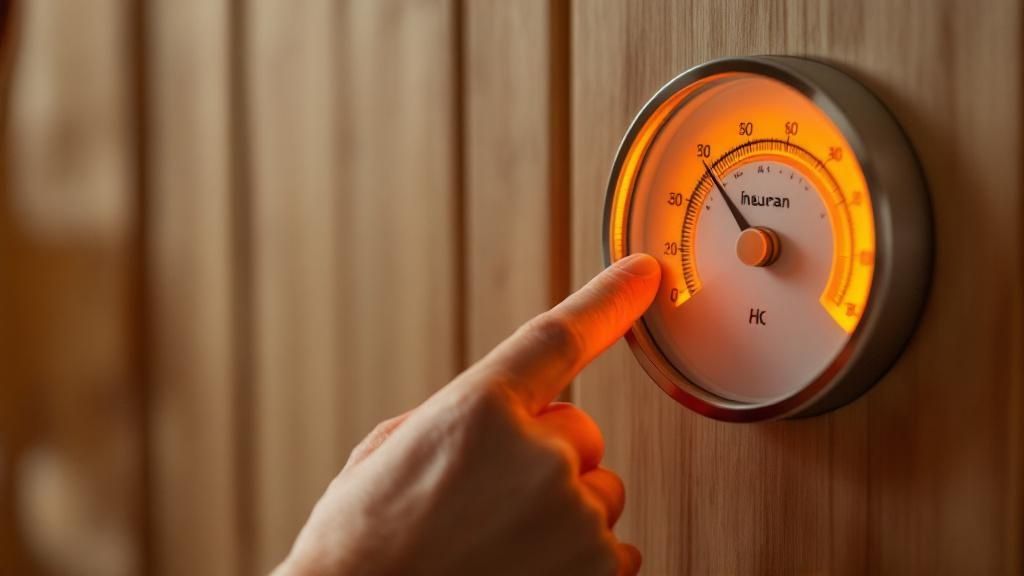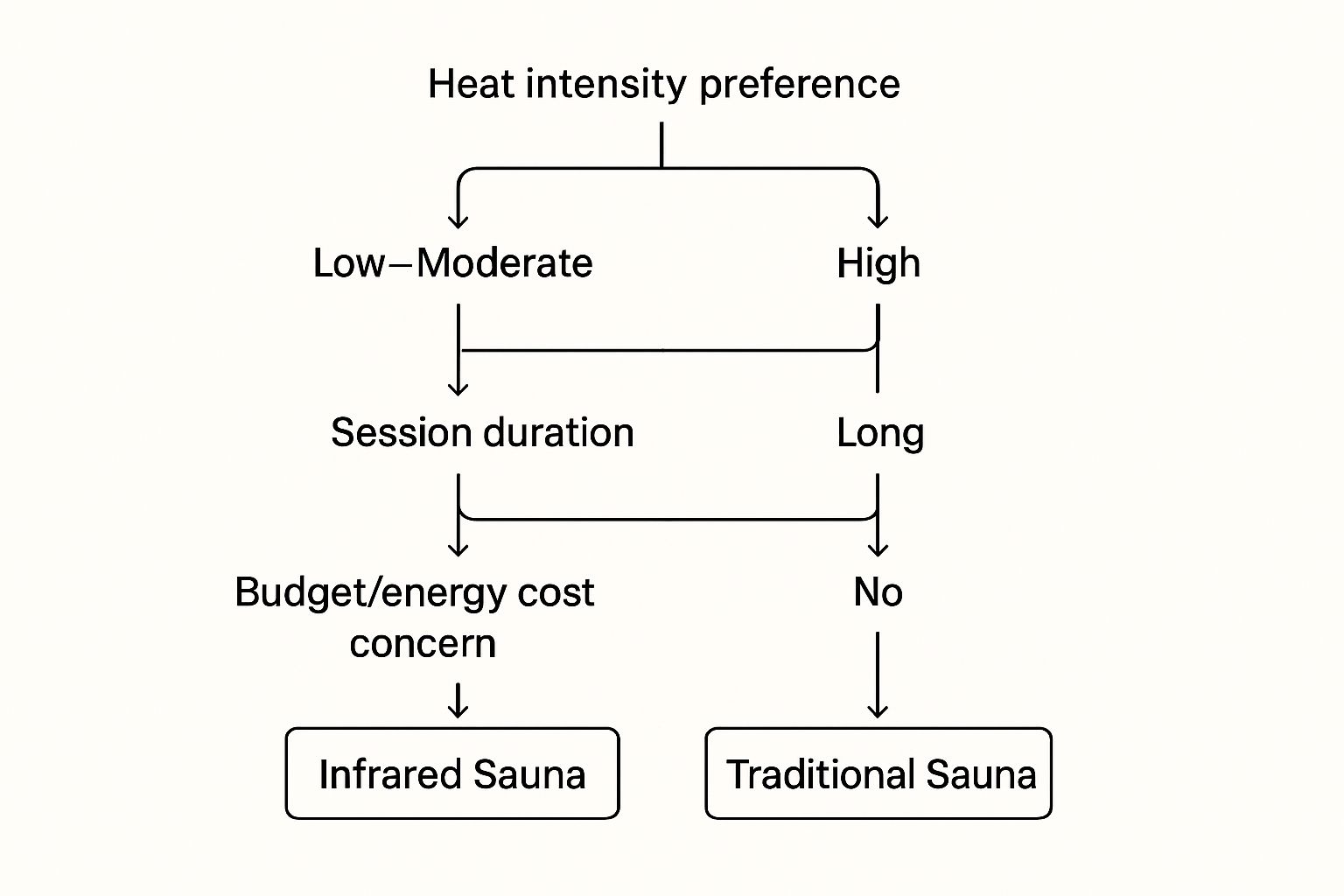When you're looking at infrared versus traditional saunas, the biggest difference really comes down to how they make you sweat. It’s not just about getting hot; it’s about the kind of heat and how your body experiences it. A traditional sauna blasts the air around you with high heat, which then warms your body. It …
When you're looking at infrared versus traditional saunas, the biggest difference really comes down to how they make you sweat. It’s not just about getting hot; it’s about the kind of heat and how your body experiences it.
A traditional sauna blasts the air around you with high heat, which then warms your body. It creates that classic, intensely hot, and often steamy environment that many people associate with a good sweat session. In contrast, an infrared sauna uses light to warm your body directly from the inside out. The heat is much more gentle, but it produces a surprisingly deep and detoxifying sweat.
Infrared Heat vs. Traditional Steam: A Head-to-Head Comparison
Understanding how these two therapies work is the first step to figuring out which one is the right fit for you. While both are designed to make you sweat for wellness, their methods create entirely different experiences and can lead to different health outcomes. One isn't simply "better" than the other, but one will almost certainly align better with your personal comfort and goals.
The real fork in the road is the heat source. Traditional saunas use a stove (electric or wood-fired) to heat the air to between 150°F and 195°F. This is a classic dry heat, but you can toss water on the rocks to create a burst of steam.

On the other hand, infrared saunas run at a much cooler 120°F to 140°F. They use special lamps to emit infrared light waves that penetrate your tissues directly. This allows you to work up a serious sweat without having to endure overwhelming ambient temperatures, which is a game-changer for anyone sensitive to extreme heat.
The choice really boils down to this: Do you want to feel the heat around you (traditional) or within you (infrared)? That single difference shapes the entire experience—from how long you can comfortably stay in to the overall vibe of the session.
At a Glance: Infrared vs. Traditional Sauna
To make it even clearer, let's break down the main distinctions in a simple table. Think of this as a quick reference guide to see how each sauna type stacks up. If you're curious about how different types of light waves work on the body, you can also explore our complete guide on red light therapy.
| Feature | Infrared Sauna | Traditional Sauna |
|---|---|---|
| Heating Method | Uses infrared light waves to heat the body directly from within. | Heats the surrounding air with an electric or wood stove. |
| Operating Temp. | Runs at a lower, more gentle temperature, typically 120°F to 140°F. | Operates at a higher temperature, typically 150°F to 195°F. |
| Humidity Level | Very low humidity for a consistently dry heat experience. | Can be customized with steam by adding water to hot rocks ("löyly"). |
| Heat Penetration | The heat penetrates deep into muscle and soft tissue. | The heat primarily warms the surface of the skin. |
Now that we have a solid foundation, we can dive deeper into the unique benefits and practical uses for each sauna type throughout the rest of this guide.
How They Work: The Science Behind the Heat
To really get to the heart of the infrared vs. traditional sauna debate, you have to look at how they actually heat your body. They're built on completely different principles, and that's what shapes everything from how the session feels to the benefits you walk away with. One is all about heating the air around you, while the other heats your body directly.
A traditional Finnish sauna works through convection and conduction. You've got an electric or wood stove heating up a pile of rocks (called the kiuas) until they are incredibly hot. Those stones then radiate heat into the room, cranking the air temperature up to anywhere between 150°F and 195°F.
It's this super-hot air that warms you up. And for the classic sauna experience, there's löyly—the Finnish word for ladling water over the hot rocks. This creates a big, powerful wave of steam that spikes the humidity and makes the heat feel even more intense on your skin.
The Mechanics of Infrared Heat
Infrared saunas are a whole different ballgame. They run on radiant heat. Instead of warming up the air, special emitters send out infrared wavelengths that your body absorbs directly. A great way to think about it is like standing in the sun on a cool, breezy day—you can feel the sun's warmth on your skin even though the air itself isn't hot.
This direct heating method is much more efficient, so the sauna can run at a significantly lower temperature, usually between 120°F and 140°F. For many people, this makes for a gentler, more comfortable session that's easier to enjoy for longer periods.
The key difference is this: a traditional sauna heats you from the outside in by warming the air first. An infrared sauna heats you from the inside out as your body directly absorbs the radiant heat.
Infrared saunas also get a bit more technical, breaking the technology down by wavelength. Each one has a slightly different job to do.
- Near-Infrared (NIR): This is the shortest wavelength, and it works mostly on the surface of your skin. It’s the one people often turn to for skin rejuvenation and boosting cellular health.
- Mid-Infrared (MIR): Going a little deeper, MIR wavelengths penetrate into the body's soft tissues. This is great for helping increase circulation and getting more oxygen to areas that need it, like sore muscles or joints.
- Far-Infrared (FIR): This is the longest wavelength, and it penetrates the deepest. FIR is the real workhorse when it comes to raising your core body temperature, which is what triggers that deep, detoxifying sweat.
Most of the infrared saunas you'll find today are "full-spectrum," which means they use all three wavelengths together to give you a broad range of benefits in one go. If you want to dive deeper into how this all works, our guide on infrared sauna technology breaks it all down. This fundamental difference in heating science is exactly why the two sauna experiences feel so distinct and offer their own unique results.
Evaluating the Health and Wellness Benefits

When you're comparing infrared vs. traditional saunas, it's easy to get tangled up in marketing jargon. Let's cut through the noise. The core purpose of any sauna is to raise your body's temperature and make you sweat—and both types nail this. The real conversation starts when we look at how they do it and what that means for your health.
Even though the heat delivery is different, many of the big physiological benefits are the same. The warmth from both saunas kicks your cardiovascular system into gear, mimicking the effects of moderate exercise. This improves circulation and is great for heart health. It also triggers a release of endorphins, which is why you feel so relaxed and stress-free afterward.
The debate usually heats up (pun intended) over which one is "better" for specific goals. Infrared fans love to point out how the heat penetrates tissue more deeply, suggesting it's superior for muscle recovery and pain relief. On the other hand, traditional saunas get high praise for improving respiratory function, especially when you add steam to the mix.
Cardiovascular Health and Stress Reduction
One of the most proven benefits of sauna use is better cardiovascular function. As your core temperature climbs, your heart rate speeds up and your blood vessels widen in a process called vasodilation. Over time, this response can help lower blood pressure and strengthen your entire cardiovascular system.
Both sauna types deliver this benefit in a big way. It doesn't matter if it's the intense, room-filling heat of a traditional sauna or the deep radiant heat from an infrared one; your body has to work hard to cool down. This gives your heart a healthy, gentle workout.
The main takeaway here? Consistency is everything. The best sauna for your heart is the one you'll actually use regularly, regardless of the heat source.
This physical response also does wonders for your stress levels. The heat prompts your body to release endorphins—those feel-good chemicals—while also tamping down on cortisol, the primary stress hormone. The result is a powerful sense of relaxation and mental clarity that sticks with you long after you've toweled off.
Detoxification and Muscle Recovery
The idea of "detox" is a huge selling point, especially for infrared saunas. The claim is that because infrared heat goes deeper, it produces a sweat with a higher concentration of toxins. Now, it's absolutely true that sweating is one of the body's natural ways to get rid of waste. But the evidence that one sauna type is significantly better at this than the other just isn't there yet.
Despite what you might read online, a 2022 review from Western Sydney University pointed out a lack of strong comparative data to support the idea that infrared saunas are substantially better for detoxification. The bottom line is that both make you sweat heavily, and that heavy sweating supports your body's natural cleansing processes.
When it comes to muscle recovery, the direct heat from an infrared sauna might have a slight edge. By warming muscles and joints from the inside out, it can potentially increase flexibility and soothe soreness more directly. That said, the intense heat of a traditional sauna also ramps up circulation, which rushes oxygen-rich blood to tired muscles and helps them repair. You can dive deeper into different holistic therapies on our wellness blog to see how this fits into a broader recovery plan.
Ultimately, the choice often boils down to what feels best for you, not a clear-cut scientific winner. Both saunas offer a powerful suite of wellness benefits, and the right one really depends on your personal health goals and what kind of heat you enjoy most.
When you're looking beyond general wellness and trying to tackle specific health issues, the "infrared vs. traditional sauna" debate gets a lot more interesting. The way these two saunas deliver heat creates very different therapeutic effects, especially for people dealing with chronic pain or respiratory problems. One might be a game-changer for you, while the other falls flat.
Soothing Deep Aches vs. Clearing Airways
If you're struggling with stubborn joint pain or muscle stiffness, the deep, penetrating warmth of an infrared sauna is often the better choice. Infrared waves don't just heat the air around you; they heat your body directly from the inside out. This allows the warmth to reach deep into your soft tissues and joints, which can ramp up blood flow and dial down inflammation right at the source.
On the other hand, the steamy, humid environment of a traditional sauna is a haven for your respiratory system. When you ladle water onto those hot rocks, the burst of steam works wonders to open up airways, loosen congestion, and soothe irritated bronchial passages. It's a classic for a reason.
Matching the Sauna to Your Specific Needs
The right choice really comes down to matching the sauna's strengths to your condition. Someone with chronic arthritis is likely to get more relief from an infrared session that eases joint stiffness directly. In contrast, a person suffering from seasonal allergies or a nasty chest cold would probably find the moist heat of a traditional sauna far more comforting.
This isn't just anecdotal. Clinical studies have shown that regular sauna use can lead to measurable improvements for both issues. We've seen positive effects in patients with Chronic Obstructive Pulmonary Disease (COPD) from consistent sessions. Similarly, infrared saunas have been shown to reduce pain and fatigue in those with conditions like rheumatoid arthritis. You can dig into some of these sauna therapy findings on goodrx.com if you want to see the data.
It all goes to show how the unique environment of each sauna creates distinct therapeutic advantages.
The real question to ask yourself is about the nature of your discomfort. Is the problem deep within your muscles and joints? Or is it more about your breathing and sinuses? Your answer will almost always point you to the most effective heat therapy for you.
To make it even clearer, let's break it down into a couple of real-world scenarios:
-
For Joint Pain (like Arthritis): The infrared sauna is usually the top recommendation. Its ability to penetrate up to 1.5 inches into the body delivers soothing warmth directly to stiff, painful joints. This can promote flexibility and ease discomfort without having to endure scorching air temperatures.
-
For Respiratory Support (like Asthma or Bronchitis): The traditional sauna typically comes out ahead here. That potent combination of heat and steam acts like a natural expectorant, helping clear mucus from your lungs and sinuses. The result? Breathing feels easier and much more comfortable.
At the end of the day, both saunas offer powerful relief, but their strengths are specialized. By understanding how their heating methods align with different physiological needs, you can make a much more informed choice to support your own health journey.
Comparing the Sauna Experience and Atmosphere

Let’s be honest: the best sauna for you is the one you'll actually use consistently. And a huge part of that comes down to the overall experience. Comparing an infrared sauna to a traditional one is a bit like comparing a quiet meditation room to a lively, social steam bath. They each cultivate a totally different vibe and physical sensation.
A traditional sauna is all about intense, enveloping heat. We're talking air temperatures hitting anywhere from 150°F to 195°F. When you ladle water over the hot stones—a Finnish practice known as löyly—it creates this powerful, humid wave of steam that makes the experience feel even more potent. This environment is often social, tapping into a centuries-old ritual of community and shared wellness.
On the other hand, an infrared sauna offers a much gentler experience. The air temperature hovers in a more comfortable range of 120°F to 140°F, so it feels less like an oven and more like you're basking in warm sunlight. Because the infrared waves warm your body directly instead of heating the air, the atmosphere is dry, quiet, and perfect for solo relaxation, meditating, or even listening to a podcast.
Comfort and Session Duration
Your personal tolerance for heat is going to be a major factor here. If you find high temperatures overwhelming or a little claustrophobic, the milder conditions of an infrared sauna will feel like a breath of fresh air. The lower ambient heat allows for longer, more comfortable sessions, often lasting 30 to 45 minutes.
Traditional sauna sessions are typically shorter and more intense. Most people stick to 15 to 20 minutes per round. For some, the high heat and humidity are invigorating, but for others, it can be a real challenge. That's why many people cycle through several short sessions, breaking them up with a cold plunge or a cool shower in between.
The choice really boils down to your personal wellness style. Are you looking for an intense, purifying ritual that can be a shared social experience? Or do you prefer a gentle, prolonged session for quiet contemplation and deep relaxation?
Personal Preference Scenarios
To help you figure out what fits you best, think about which of these scenarios sounds more appealing for your routine:
-
The Social Traditionalist: You enjoy the ritual of the sauna and might want to share the experience with friends or family. You love the feeling of intense heat and steam, and you find the cycle of hot and cold sessions deeply refreshing and energizing.
-
The Solo Meditator: You see sauna time as your personal escape for quiet reflection. You're sensitive to extreme temperatures and would rather have a longer, gentler session where you can relax deeply without feeling overwhelmed by the heat.
Ultimately, the atmosphere of an infrared or traditional sauna directly impacts how often you’ll use it—and consistency is the real key to unlocking all those great health benefits.
Making Your Choice: Which Sauna Fits Your Lifestyle?
So, how do you choose? The showdown between infrared and traditional saunas isn't about finding a definitive winner. It’s about figuring out which one aligns with your personal health goals, your daily routine, and the practical realities of your home and budget.
The best sauna is the one you’ll actually use consistently—that's where the real benefits kick in.
Your "why" is the best place to start. If you're an athlete laser-focused on deep muscle recovery, the targeted radiant heat of an infrared sauna might be your perfect match. It’s designed to penetrate tissues directly and efficiently. But if you crave the ritual, the social connection, and that intense, steamy heat for pure stress relief, then a classic Finnish-style sauna is probably calling your name.
Practical Realities: Installation and Costs
Beyond the experience itself, you have to think about the real-world stuff: installation and running costs. This is often where the decision gets made.
Infrared saunas tend to be the more budget-friendly option upfront. They often come as pre-fabricated kits that are surprisingly easy to assemble, sometimes just plugging into a standard outlet. They also run at lower temperatures, meaning they sip energy instead of guzzling it, which keeps your utility bills down over time.
A traditional sauna, especially a custom-built one, is a bigger initial investment. These units require more complex electrical work and proper ventilation, which usually means hiring a professional for installation. While they use more energy per session, a well-insulated traditional sauna holds its heat incredibly well, making it a durable, long-term wellness fixture in your home.
Think carefully about your space and budget. The plug-and-play nature of an infrared sauna makes it a great fit for many homes, even apartments. A traditional sauna is a more permanent, immersive installation that truly becomes the centerpiece of a dedicated wellness space.
Before you make a final call, this quick guide can help match your goals to the right sauna experience.
Decision Guide: Which Sauna Fits Your Needs?
| Your Primary Goal or Preference | Recommended Sauna Type | Reasoning |
|---|---|---|
| Deep muscle and joint pain relief | Infrared Sauna | The radiant heat penetrates deeply into tissues, providing targeted relief for chronic pain, soreness, and arthritis. |
| You love high heat and steam | Traditional Sauna | Nothing beats the intense, enveloping heat and the ability to create steam by pouring water over hot rocks for a classic "löyly" experience. |
| Quick, convenient sessions | Infrared Sauna | Heats up in just 10-15 minutes, making it easy to fit a session into a busy schedule without a long wait. |
| Socializing and group relaxation | Traditional Sauna | Generally larger and more spacious, they are designed for communal use, making them perfect for family or friends. |
| You have respiratory sensitivities | Infrared Sauna | The dry, lower-temperature heat is much gentler on the lungs and sinuses compared to the high humidity of a traditional sauna. |
| A complete, holistic detox | Traditional Sauna | The intense heat induces a powerful sweat that flushes toxins from the skin's surface, while the steam helps open up pores. |
| Lower energy bills are a priority | Infrared Sauna | Operates at a lower temperature and often requires less power, resulting in significantly lower operating costs over its lifetime. |
| Creating a permanent wellness sanctuary | Traditional Sauna | A custom-built traditional sauna becomes a beautiful, permanent feature of your home, adding long-term value and a dedicated relaxation space. |
Ultimately, whether you lean toward an infrared or a traditional sauna, you're investing in your health. The key is to be honest about what you need—a targeted therapeutic tool or a powerful space for holistic escape. Answering that question will point you to the right choice, ensuring your investment pays you back in health and well-being for years to come.
Your Sauna Questions, Answered
Stepping into the world of saunas, whether infrared or traditional, naturally brings up a few questions. Getting the most out of your experience means knowing how to use them safely and effectively, respecting your body's signals while you soak up the benefits.
Let's talk about timing. A session in a traditional sauna is usually a shorter, more intense affair, typically lasting between 15 to 20 minutes. On the other hand, the gentler, radiant heat of an infrared sauna allows for a longer, more relaxing session, often stretching from 30 to 45 minutes.
As for how often you should go, a good rule of thumb is to start slow. Most people find that one or two sessions a week is the perfect introduction. As your body gets used to it, you can comfortably work your way up to three or four times weekly.
How Do I Choose The Right Sauna?
Sometimes, the best way to decide is to see what fits your lifestyle. This simple decision tree can help you figure out which sauna is a better match for your preferences on heat, time, and budget.

As you can see, your personal comfort with heat intensity, along with practical things like your budget, will quickly guide you toward the right choice.
No matter which sauna you choose, the most important safety rule is universal: listen to your body. If you start to feel dizzy, nauseous, or just "off," it's time to end your session. And remember, staying well-hydrated before, during, and after is absolutely non-negotiable for a safe and effective experience.
While saunas are generally very safe, they aren't for everyone. If you have a pre-existing medical condition like an unstable heart condition, low blood pressure, or if you are pregnant, it's always best to talk with your doctor before starting any sauna routine. Understanding the unique benefits of an infrared sauna vs. a traditional sauna helps you make a choice that truly supports your wellness journey.
Ready to experience the deep, restorative heat of a professional-grade infrared sauna? At Healing Waters Wellness Center, we provide a serene environment for you to relax, detoxify, and rejuvenate. Book your session today and discover a new level of well-being.






